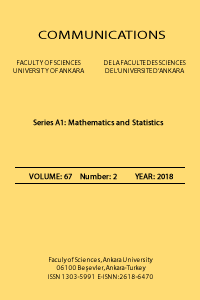The mean remaining strength of parallel systems in a stress-strength model based on exponential distribution
Mean remaining strength, exponential and generalized exponential distributions stress-strength model,
___
- Birnbaum, Z. W., On a use of Mann-Whitney statistics, in Proc. 3rd Berkeley Symposium on Mathematical Statistics and Probability 1, (1956), 13-17.
- Birnbaum, Z. W. and McCarty, B. C., A distribution-free upper confidence bounds for Pr(Y
- Kotz, S., Lumelskii, Y., Pensky, M., The Stress-Strength Model and its Generalizations: Theory and Applications, World Scientific, Singapore, 2003.
- Kundu, D., Gupta, R. D., Estimation of P(Y
- Basirat, M., Baratpour, S. and Ahmadi, J., Statistical inferences for stress--strength in the proportional hazard models based on progressive Type-II censored samples, Journal of Statistical Computation and Simulation 85(3), (2015), 431-449.
- Basirat, M., Baratpour, S. and Ahmadi, J., On estimation of stress-strength parameter using record values from proportional hazard rate models, Communications in Statistics - Theory and Methods 45(19), (2016), 5787-5801.
- Asgharzadeh, A., Kazemi, M. and Kundu, D., Estimation of P(X>Y) for Weibull distribution based on hybrid censored samples, International Journal of System Assurance Engineering and Management 8(1), (2017), 489-498.
- Bhattacharyya, G. K. and Johnson, R. A. Estimation of reliability in multicomponent stress-strength model, Journal of American Statistical Association 69, (1974), 966-970.
- Bhattacharyya, G. K. and Johnson, R. A. Stress--strength models for system reliability, Proceedings of the Symposium on Reliability and Fault Tree Analysis SIAM, (1975), 509-532.
- Eryilmaz, S., Consecutive k-Out-of-n : G System in Stress-Strength Setup, Communications in Statistics - Simulation and Computation, 37(3), (2008), 579-589.
- Eryilmaz, S., On system reliability in stress-strength setup, Statistics & Probability Letters 80, (2010), 834-839.
- Pakdaman, Z. and Ahmadi, J., Stress-strength reliability for P(X_{r:n₁}
- Pakdaman, Z. and Ahmadi, J., Point estimation of the stress-strength reliability parameter for parallel system with independent and non-identical components, Communications in Statistics-Simulation and Computation, 47(4), (2018), 1193-1203.
- Hassan, M. K. H., Estimation a stress-strength model for P(Y_{r:n₁}
- Kızılaslan, F., Classical and Bayesian estimation of reliability in a multicomponent stress--strength model based on the proportional reversed hazard rate mode, Mathematics and Computers in Simulation 136, (2017), 36-62.
- Gürler, S., The mean remaining strength of systems in a stress-strength model, Hacettepe Journal of Mathematics and Statistics 42(2), (2013), 181-187.
- Bairamov (Bayramoglu), I., Gurler, S. and Ucer, B., On the mean remaining strength of the k-out-of-n:F system with exchangeable components, Communications in Statistics-Simulation and Computation 44(1), (2015), 1-13.
- Gurler, S., Ucer, B. H. and Bairamov, I., On the mean remaining strength at the system level for some bivariate survival models based on exponential distribution, Journal of Computational and Applied Mathematics 290, (2015), 535-542.
- Gupta, R. D. and Kundu, D., Generalized exponential distributions, Australian & New Zealand Journal of Statistics 41, (1999), 173-188.
- Dewan, I. and Khaledi, B., On stochastic comparisons of residual life time at random time, Statistics and Probability Letters 88, (2014), 73-79.
- Misra, N. and Naqvi, S., Stochastic comparison of residual lifetime mixture models, Operations Research Letters 46, (2018), 122-127.
- Misra, N. and Naqvi, S., Some unified results on stochastic properties of residual lifetime at random times, Brazilian Journal of Probability and Statistics 32(2), (2018), 422-436
- Shakedand, M. and Shanthikumar, J. G., Stochastic Orders, Springer Series in Statistics, 2007.
- Ghitany, M. E., Al-Jarallah, R. A. and Balakrishnan, N., On the existence and uniqueness of the MLEs of the parameters of a general class of exponentiated distributions, Statistics 47(3), (2013), 605-612.
- Gradshteyn, I. S and Ryzhik, I. M., Table of Integrals, Series and Products, 5th ed. Boston, USA: Academic Press, 2007.
- Rao, C. R., Linear Statistical Inference and Its Applications. New York: Wiley; 1965.
- Lindley, D. V., Approximate Bayes method, Trabajos de Estadistica 3, (1980), 281-288.
- Gelman, A., Carlin, J. B., Stern, H. S. and Rubin, D. B., Bayesian Data Analysis. Chapman Hall, London, 2003.
- Chen, M. H. and Shao, Q. M., Monte Carlo estimation of Bayesian credible and HPD intervals, Journal of Computational and Graphical Statistics 8(1), (1999), 69-92.
- ISSN: 1303-5991
- Yayın Aralığı: Yılda 4 Sayı
- Başlangıç: 1948
- Yayıncı: Ankara Üniversitesi
A. M. ALOTAİBİ, M. S. M. NOORANİ, M. A. EL-MONEAM
G MOHANAPPRİYA, D. VİJAYALAKSHMİ
G. KALPANA, Z. Sumaiya TASNEEM
